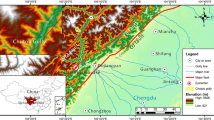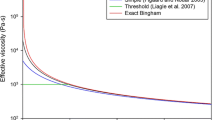Abstract
Debris flow is a rapid flow which could lead to severe flooding with catastrophic consequences such as damage to properties and loss of human lives. It is important to study the movement of debris flow. Since during a debris flow process, the erosion and deposition processes are important, the no entrainment assumption is not acceptable. In this study, first we considered the debris flow as equivalent fluid and adopted the depth-averaged govern equations to simulate the movements and evolution of river bed. Secondly, the set of partial differential equations was solved numerically by means of explicit staggered leap-frog scheme that is accurate in space and time. The grid of difference scheme was derived from GIS raster data. Then the simulation results can be displayed by GIS and easily used to form the hazard maps. Finally, the numerical model coupled with GIS is applied to simulate the debris flow occurred on Oct. 20th, 2010, in Amamioshima City, Japan. The simulation reproduces the movement, erosion and deposition. The results are shown to be consistent with the field investigation.
Similar content being viewed by others
References
Tang C, Rengers N, Yang Y H, Wang G F. Triggering conditions and depositional characteristics of a disastrous debris flow event in Zhouqu city, Gansu Province, northwestern China. Natural Hazards and Earth System Sciences, 2011, 11(11): 2903–2912
Roy C S, Masahiro C. Landslides and debris flows strike Kyushu, Japan. Eos, Transactions, American Geophysical Union, 2004, 85: 145–156
Armanini A, Fraccarollo L, Rosatti G. Two-dimensional simulation of debris flows in erodible channels. Computers & Geosciences, 2009, 35: 993–1006
Hungr O. A model for the runout analysis of rapid flow slides, debris flows, and avalanches. Canadian Geotechnical Journal, 1995, 32: 610–623
Hungr O, Evans S G. A dynamic model for landslides with changing mass. In: Marinos, Koukis, Tsiambaos and Stournaras, eds. Engineering Geology and the Environment. Athens, Greece, 1997, 719–724
Rickenmann D, Koch T. Comparison of debris flow modelling approaches. In: Chen C L, ed. Debris-Flow Hazards Mitigation: Mechanics, Prediction, and Assessment. Proceedings of the first International DFHM Conference. ASCE, New York, USA, 1997, 576–585
Coussot P. Some considerations on debris flow rheology. In: Ergenzinger P, Schmidt K H, eds. Dynamics and Geomorphology of Mountain Rivers, Dynamics and Geomorphology of Mountain Rivers. Lectures Notes in Earth Sciences 52, Berlin, 1994, 315–326
Whipple K X. Open channel flow of Bingham Fluids: Applications on debris flow research. Journal of Geology, 1997, 105: 243–262
Brufau P, Garcia-Navarro P, Ghilardi P, Natale L, Savi F. 1D mathematical modelling of debris flow. Journal of Hydraulic Research, 2000, 38: 435–446
Nakagawa H, Takahashi T. Estimation of a debris flow hydrograph and hazard area. In: Chen C L, eds. Debris-Flow Hazards Mitigation: Mechanics, Prediction, and Assessment. Proceedings of the first International DFHM Conference. San Francisco, CA, USA, 1997, 64–73
Nakagawa H, Takahashi T, Satofuka Y. A debris-flow disaster on the fan of the Harihara River, Japan. In:Wieczorek G F, Naeser N D, eds. Debris-Flow Hazards Mitigation: Mechanics, Prediction, and Assessment. Proceedings of Second International DFHM Conference. Taipei, China, 2000, 193–201
Shieh C L, Jan C D, Tsai Y F. A numerical simulation of debris flow and its applications. Natural Hazards, 1996, 13: 39–54
Takahashi T. Debris Flow, IAHR Monograph Series. Rotterdam: Balkema, 1991
Takahashi T, Nakagawa H, Harada T, Yamashiki Y. Routing debris flows with particle segregation. Journal of Hydraulic Engineering, 1992, 118(11): 1490–1507
Zanre D D L, Needham D J. On simple waves and weak shock theory for the equations of alluvial river hydraulics. Philosophical Transactions of the Royal Society A, 1996, 354: 2993–3054
Lai C. Modelling alluvial channel flow by multimode characteristic method. Journal of Engineering Mechanics, 1991, 117: 32–53
Morris P H, Williams D J. Relative celerities of mobile bed flows with finite solid concentration. Journal of Hydraulic Engineering, 1996, 122: 311–315
Iverson R M. The physics of debris flows. Reviews of Geophysics, 1997, 35: 245–296
McDougall S, Hungr O. Dynamic modeling of entrainment in rapid landslides. Canadian Geotechnical Journal, 2005, 42: 1437–1448
Chen H, Crosta G B, Lee C F. Erosional effects on runout of fast landslides debris flows and avalanches: A numerical investigation. Geotechnique, 2006, 56(5): 305–322
Remaitre A. Mophologie et dynamique des laves torrentielles: Applications aux torrents des Terres Noires du basin de Barcelonnette (Alpes du Sud). Dissertation for the Doctoral Degree. Caen: Université de Caen, 2006
Vandine D F, Bovis M. History and goals of Canadian debris flow research, a review. Natural Hazards, 2002, 26: 69–82
Sovilla B, Margreth S, Bartelt P. On snow entrainment in avalanches dynamics calculations. Cold Regions Science and Technology, 2007, 47: 69–79
Mangeney A, Roche O, Hungr O, Mangold N, Faccanoni G, Lucas A. Erosion and mobility in granular collapse over sloping beds. Journal of Geophysical Research, 2010, 115: 20–25
Lin M L, Jeng S S. A preliminary study of risk assessment of debris flow using GIS. Journal of the Chinese Institute of Civil and Hydraulic Engineering, 1995, 7: 475–486 (in Chinese)
Lin J Y, Yang M D, Lin P S. An evaluation on the applications of remote sensing and GIS in the estimation system on potential debris flow. Annual Conference of Chinese Geographic Information Society (CD edition), 1998
Lin P S, Lin J Y, Hung J C, Yang M D. Risk assessment of potential debris flows using GIS. In: Proceedings of the Second International Conference on Debris-Flow. Balkema, 2000, 431–440
Cheng K Y, Lin L K, Chang S Y. The field investigation and GIS application in a potential hazardous area of debris flow. In: Debris-Flow Hazards Mitigation: Mechanics, Prediction, and Assessment, Proceedings of the First International Conference. ASCE, New York. 1997, 83–92
Imran J, Harff P, Parker G. A number model of submarine debris-flow with a graphical user interface. Computers & Geosciences, 2001, 27: 717–729
Iverson R M. The debris-flow rheology myth. In: Rickenmann D, Chen C L, eds. Debris-flow Hazards Mitigation: Mechanics, Prediction and Assessment. Rotterdam: Millpress, 2003, 303–314
Vreugdenhil C B. Numerical Methods for Shallow-Water Flow. Norwell: Kluwer Acadamic, 1994
Savage S B, Hutter K. The motion of a finite mass of granular material down a rough incline. Journal of Fluid Mechanics, 1989, 199: 177–215
Gray J M N T, Wieland M, Hutter K. Gravity-driven free surface flow of granular avalanches over complex basal topography. Proceedings of the Royal Society of London, 1999, 455: 1841–1874
Naef D, Rickenmann D, Rutschmann P, McArdell B W. Comparision of flow resistance relations for debris flows using a one-dimensional finite element simulation model. Natural Hazards and Earth System Sciences, 2006, 6: 155–165
Christen M, Kowalski J, Bartelt P. RAMMS: Numerical simulation of snow avalanches in three-dimensional terrain. Cold Regions Science and Technology, 2010, 63: 1–14
Yoshiaki I, Akihide T. Numerical simulations of flows and dispersive behaviours in southern part of lake Biwa. Disaster Prevention Research Institute Annuals, 1978, 31(B-2): 293–305 (in Japanese)
Author information
Authors and Affiliations
Corresponding author
Rights and permissions
About this article
Cite this article
Wu, J., Chen, G., Zheng, L. et al. GIS-based numerical simulation of Amamioshima debris flow in Japan. Front. Struct. Civ. Eng. 7, 206–214 (2013). https://doi.org/10.1007/s11709-013-0198-6
Received:
Accepted:
Published:
Issue Date:
DOI: https://doi.org/10.1007/s11709-013-0198-6




